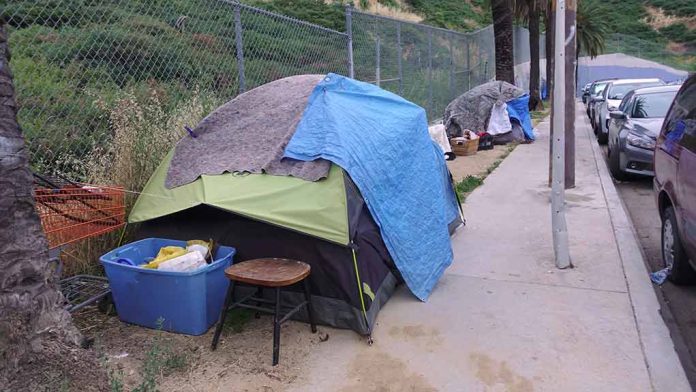
Homelessness in the United States is set to reach unprecedented levels in 2024, with migrants contributing significantly to the crisis.
At a Glance
- The U.S. is on track to surpass 2023’s record homeless figure of 653,000
- At least 550,000 people were reported homeless in January 2024
- Migrants make up a significant portion of the homeless population in family shelters
- Major cities like New York, Chicago, and Denver are experiencing sharp increases in homelessness
- High rents and low incomes remain primary drivers of the homelessness crisis
Record-Breaking Homelessness Numbers
The United States is facing an unprecedented surge in homelessness, with initial reports from over 250 homeless-service agencies estimating around 550,000 people will be homeless in 2024. This marks a staggering 10% increase from the previous year, putting the nation on track to surpass 2023’s record figure of 653,000 homeless individuals. The crisis is particularly acute in major urban centers, where an influx of migrants has exacerbated existing housing shortages and strained social services.
Cities across the country are grappling with the escalating crisis. Chicago’s homeless population has tripled to over 18,800 in January, while Denver experienced a 42% increase due to the migrant influx. California continues to have the largest homeless population in the U.S., with over 180,000 homeless individuals reported in 2023. These figures underscore the growing challenge faced by local governments and social service providers in addressing the complex issue of homelessness.
The Impact of Migrant Influx
The surge in homelessness is closely tied to the recent influx of migrants into major U.S. cities. Many of these newcomers, often transported from other states, find themselves without adequate housing upon arrival. This has put immense pressure on already strained shelter systems and social services. In Massachusetts, for example, migrants make up a significant portion of the homeless population in family shelters, with the state expecting to spend over $1 billion on housing migrants this fiscal year.
“[HUD estimates] are widely considered to be undercounts that can be swayed by how many volunteers show up or severe weather,” the Journal reported.
The situation has sparked intense public debates over resource allocation and immigration policies. Democratic officials, in particular, face growing criticism over their handling of these interconnected issues. The challenge lies in balancing humanitarian concerns with the practical realities of limited housing and social services.
US homelessness explodes after hitting record last year as migrants flood streets https://t.co/FrZyNr2hUO pic.twitter.com/usHpt0JnXG
— New York Post (@nypost) September 22, 2024
Demographic Shifts and Underlying Causes
While the migrant crisis has contributed significantly to the rise in homelessness, it’s important to note that every ethnic group saw an increase in homelessness in 2023. The Asian community experienced the most significant percentage increase at 64%, while Hispanics/Latinos saw the largest surge in raw numbers with an additional 39,106 people. Nearly two-thirds of the nation’s unhoused individuals are Black or Hispanic/Latino, despite these groups comprising only one-third of the country’s population.
High rents and low incomes remain primary drivers of homelessness across the board. The number of chronically homeless individuals has increased annually since 2016, nearly doubling during that span. Families experiencing homelessness increased by 16% in 2023, accounting for nearly one-third of the total homeless population. These trends highlight the need for comprehensive solutions that address both immediate housing needs and long-term economic factors.
Responding to the Crisis
In response to the growing crisis, the homelessness response system has added more temporary and permanent beds, resulting in a 14% increase in shelter use. More people exited temporary housing to permanent housing in 2023 compared to 2022, indicating some progress in addressing the issue. However, the scale of the problem continues to outpace current efforts.
Faith-based organizations play a crucial role in addressing homelessness, with about 75% of emergency shelter beds in the U.S. located in faith-based facilities. This underscores the importance of community involvement and partnerships in tackling the homelessness crisis. As the situation continues to evolve, it is clear that a coordinated effort involving government agencies, non-profit organizations, and local communities will be essential in addressing this complex and growing challenge.







